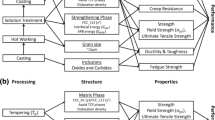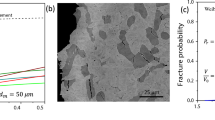Abstract
A new computational method is presented for the efficient design of alloy systems in functionally graded materials (FGMs), optimized for manufacturability (sintering) as well as performance. The design methodology uses a multi-objective genetic algorithm (GA) integrated with computational thermodynamics and physics-based predictive models to optimize the composition of each alloy in the FGM. Thermodynamic modeling, using the CALPHAD method, is used to establish microstructural constraints and calculate the effective diffusivity in each alloy of the FGM. Physics-based predictive models are used to estimate performance properties. The model is verified by comparing results with data from the literature. A design exercise is also presented for an FGM that combines a ferritic and an austenitic stainless steel to demonstrate the capability of the methodology. It is shown that the mismatch in sintering rate between the two alloys, which causes processing defects during co-sintering, can be minimized while the solution hardening and corrosion resistance in the austenitic alloy can be optimized by independently controlling the composition of both alloys, the initial particle sizes and the sintering temperature.








Similar content being viewed by others
References
Olson GB (1997) Computational design of hierarchically structured materials. Science 277:1237–1242
Pollock TM (2016) Alloy design for aircraft engines. Nat Mater 15:809–815
Deschamps A, Tancret F, Benrabah I-E, De Geuser F, Van Landeghem HP (2018) Combinatorial approaches for the design of metallic alloys. Comptes Rendus Phys 19:737–754
Li S, Kattner UR, Campbell CE (2017) A computational framework for material design. Integr. Mater. Manuf. Innov. 6:229–248
Molla TT, Liu JZ, Schaffer GB (2018) An ICME framework for design of stainless steel for sintering. Integr Mater Manuf Innov 7:136–147
Heaney DF, Suri P, German RM (2003) Defect-free sintering of two material powder injection molded components part I Experimental investigations. J Mater Sci 38:4869–4874
Johnson JL, Tan LK, Suri P, German RM (2003) Design guidelines for processing bi-material components via powder-injection molding. JOM. 55:30–34. https://doi.org/10.1007/s11837-003-0172-1
Manonukul A, Songkuea S, Moonchaleanporn P, Tange M (2017) Effect of weld line positions on the tensile deformation of two-component metal injection moulding. Int J Miner Metall Mater 24:1384–1393
Imgrund P, Rota A, Petzoldt F, Simchi A (2007) Manufacturing of multi-functional micro parts by two-component metal injection moulding. Int J Adv Manuf Technol 33:176–186
Simchi A, Rota A, Imgrund P (2006) An investigation on the sintering behavior of 316L and 17-4PH stainless steel powders for graded composites. Mater Sci Eng A 424:282–289
Mulser M, Baumann A, Ebert S, Imgrund P, Langer I, Petzoldt F (2014) Materials of high hardness and wear resistance joined to stainless steel by 2C-MIM. Adv Powder Metall & Part Mater 4:140–148
Mulser M, Petzoldt F (2016) Two-component metal injection moulding of Ti-6Al-4V and stainless steel bi-material parts. Key Eng Mater 704:148–154
Firouzdor V, Simchi A (2010) Co-sintering of M2/17-4PH powders for fabrication of functional graded composite layers. J Compos Mater 44:417–435
Cai PZ, Green DJ, Messing GL (1997) Constrained densification of alumina/zirconia hybrid laminates, 2. Viscoelastic stress computation. J Am Ceram Soc 80:1940–1948
Kanters J, Eisele U, Rodel J (2001) Cosintering simulation and experimentation: case study of nanocrystalline zirconia. J Am Ceram Soc 84:2757–2763
Frandsen HL, Olevsky E, Molla TT, Esposito V, Bjork R, Pryds N (2013) Modeling sintering of multilayers under influence of gravity. J Am Ceram Soc 96:80–89
Molla TT, Frandsen HL, Bjork R, Ni DW, Olevsky E, Pryds N (2013) Modeling kinetics of distortion in porous bi-layered structures. J Eur Ceram Soc 33:1297–1305
Olevsky EA (1998) Theory of sintering: from discrete to continuum. Mater Sci Eng R-Reports 23:41–100
Perrut M (2015) Thermodynamic modeling by the calphad method and its applications to innovative materials. J AerospaceLab:1–11. https://doi.org/10.1276/212015.AL09.10
Rahaman MN (2008) Sintering of ceramics, Taylor and Francis Group, Boca Raton
Coble RL (1961) Sintering crystalline solids .1. Intermediate and final state diffusion models. J Appl Phys 32:787
German RM (2010) Coarsening in sintering: grain shape distribution, grain size distribution, and grain growth kinetics in solid-pore systems. Crit Rev Solid State Mater Sci 35:263–305
Walbrühl M, Linder D, Ågren J, Borgenstam A (2017) Modelling of solid solution strengthening in multicomponent alloys. Mater Sci Eng A 700:301–311
McGuire MF (2008) Stainless steels for design engineers. ASM International, Materials Park
Shukla PK, Deb K (2007) On finding multiple Pareto-optimal solutions using classical and evolutionary generating methods. Eur J Oper Res 181:1630–1652
Jamaludin KR, Muhamad N, Rahman MNA, Amin SYM, Ahmad S, Ibrahim MHI (2009) Sintering Parameter Optimisation of the SS316L metal injection molding (MIM) compacts for final density using Taguchi Method, 3rd South East Asian Tech. Univ Consort Symp:258–262
Molla T, Ramachandran D, Esposito V, Ni D, Teocoli F, Olevsky E, Bjork R, Pryds N, Kaiser A, Frandsen H (2015) Constrained sintering of bi-layered tubular structures. J Eur Ceram Soc Ceram Soc 35:941–950
Funding
This work was funded by The University of Melbourne.
Author information
Authors and Affiliations
Contributions
G.B.S. conceived the initial idea, supervised the project, and contributed to writing the manuscript. T.T.M. extended the idea, developed the model, performed simulations, and wrote the manuscript. J.Z.L. provided critical comments and contributed to revisions of the manuscript.
Corresponding author
Ethics declarations
Competing Interests
The authors declare that they have no competing interests.
Additional information
Publisher’s Note
Springer Nature remains neutral with regard to jurisdictional claims in published maps and institutional affiliations.
Rights and permissions
About this article
Cite this article
Molla, T.T., Liu, J.Z. & Schaffer, G.B. Computational Design of Functionally Graded Materials from Sintered Powders. Integr Mater Manuf Innov 8, 82–94 (2019). https://doi.org/10.1007/s40192-019-00127-6
Received:
Accepted:
Published:
Issue Date:
DOI: https://doi.org/10.1007/s40192-019-00127-6




